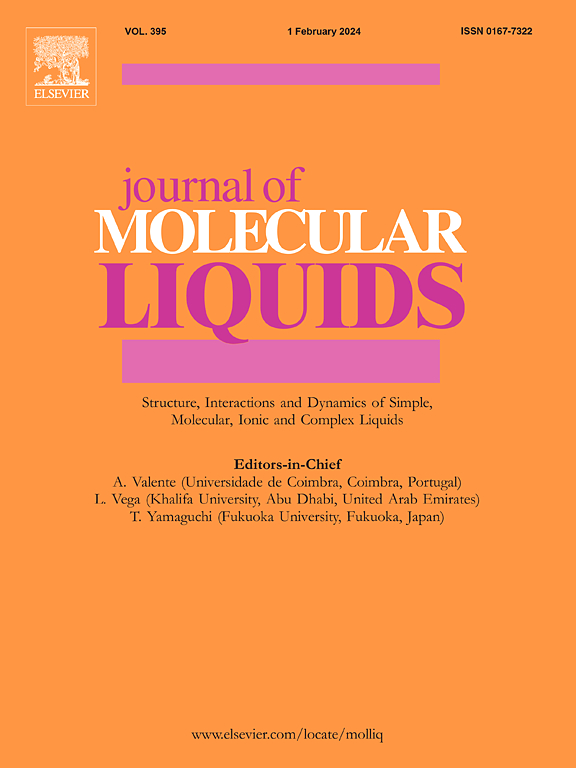两种不同极性表面活性剂和长链醇的压电晶体水凝胶
IF 5.3
2区 化学
Q2 CHEMISTRY, PHYSICAL
引用次数: 0
摘要
压电材料具有电容性,能将机械变形转化为电能。两性离子表面活性剂cocamidopropyl hydroxysultaine (CAPS)和阴离子表面活性剂十二烷基硫酸钠(SDS)具有不同的偶极矩。CAPS和水的二元混合物是电容性的,尽管它们是液体或不粘连的。傅里叶变换红外光谱显示,CAPS通过其氨基和硫酸盐基团与癸醇相互作用。用差示扫描量热法观察到一种熔点为~ 31°C的caps -癸醇配合物。偏振光显微镜和剪切流变学研究表明,1:1:14 CAPS:癸醇:水(摩尔基)的混合物为双折射凝胶,弹性模量G′大于损失模量G′”。在小角X射线散射(SAXS)区域的X射线衍射表明,它们具有立方晶体结构。CAPS和癸醇的水相混合物也是电容性和压电性的。SAXS表明,与caps -癸醇混合物相比,caps -辛醇的相互作用更弱,其水溶液混合物更无定形。SDS在与水和辛醇或癸醇混合时也会产生结晶的双折射凝胶。然而,SDS具有比CAPS更小的偶极矩,并且这些凝胶的电容性更小。本文章由计算机程序翻译,如有差异,请以英文原文为准。

Piezoelectric crystalline hydrogels of two surfactants with different polarity and long-chain alcohols
Piezoelectric materials are capacitive and transform mechanical deformations into electricity. The zwitterionic surfactant cocamidopropyl hydroxysultaine (CAPS) and the anionic surfactant sodium dodecyl sulfate (SDS) have a different dipole moment. Binary mixtures of CAPS and water are capacitive, although they are liquid or incohesive. CAPS interacts with decanol through its amino and sulfate groups, as revealed by Fourier transform infrared spectroscopy. A CAPS-decanol complex with a melting point of ∼31 °C is observed by differential scanning calorimetry. Mixtures of 1:1:14 CAPS:decanol: water (mole based) are birefringent gels, with an elastic modulus G' greater than the loss modulus G", as shown by polarized light microscopy and shear rheology. They have a cubic crystalline structure, as shown by X-ray diffraction in the small angle X ray scattering (SAXS) region. Aqueous mixtures of CAPS and decanol are also capacitive and piezoelectric. CAPS-octanol interactions are weaker, and their aqueous mixtures are more amorphous compared to CAPS-decanol mixtures, as revealed by SAXS. SDS also yields crystalline, birefringent gels upon mixing with water and either octanol or decanol. However, SDS has a smaller dipole moment than CAPS, and these gels are less capacitive.
求助全文
通过发布文献求助,成功后即可免费获取论文全文。
去求助
来源期刊

Journal of Molecular Liquids
化学-物理:原子、分子和化学物理
CiteScore
10.30
自引率
16.70%
发文量
2597
审稿时长
78 days
期刊介绍:
The journal includes papers in the following areas:
– Simple organic liquids and mixtures
– Ionic liquids
– Surfactant solutions (including micelles and vesicles) and liquid interfaces
– Colloidal solutions and nanoparticles
– Thermotropic and lyotropic liquid crystals
– Ferrofluids
– Water, aqueous solutions and other hydrogen-bonded liquids
– Lubricants, polymer solutions and melts
– Molten metals and salts
– Phase transitions and critical phenomena in liquids and confined fluids
– Self assembly in complex liquids.– Biomolecules in solution
The emphasis is on the molecular (or microscopic) understanding of particular liquids or liquid systems, especially concerning structure, dynamics and intermolecular forces. The experimental techniques used may include:
– Conventional spectroscopy (mid-IR and far-IR, Raman, NMR, etc.)
– Non-linear optics and time resolved spectroscopy (psec, fsec, asec, ISRS, etc.)
– Light scattering (Rayleigh, Brillouin, PCS, etc.)
– Dielectric relaxation
– X-ray and neutron scattering and diffraction.
Experimental studies, computer simulations (MD or MC) and analytical theory will be considered for publication; papers just reporting experimental results that do not contribute to the understanding of the fundamentals of molecular and ionic liquids will not be accepted. Only papers of a non-routine nature and advancing the field will be considered for publication.
 求助内容:
求助内容: 应助结果提醒方式:
应助结果提醒方式:


